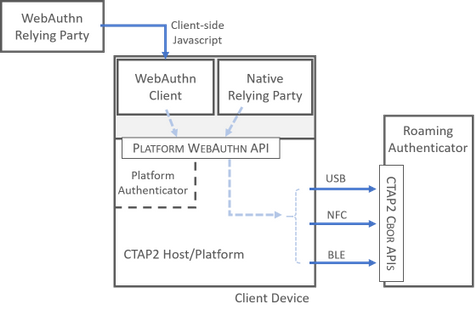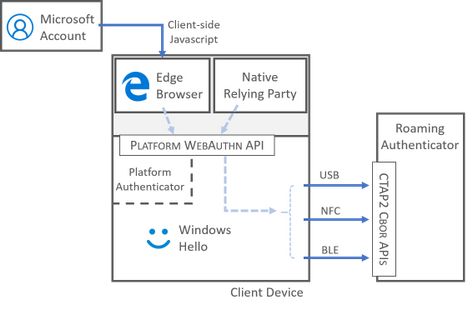WebAuthn APIs for passwordless authentication on Windows
Passwords can leave your customers vulnerable to data breaches and security attacks by malicious users.
Microsoft has long been a proponent of passwordless authentication, and has introduced the W3C/Fast IDentity Online 2 (FIDO2) Win32 WebAuthn platform APIs in Windows 10 (version 1903).
Starting in Windows 11, version 22H2, WebAuthn APIs support ECC algorithms.
What does this mean?
By using WebAuthn APIs, developer partners and the developer community can use Windows Hello or FIDO2 Security Keys to implement passwordless multi-factor authentication for their applications on Windows devices.
Users of these apps or sites can use any browser that supports WebAuthn APIs for passwordless authentication. Users will have a familiar and consistent experience on Windows, no matter which browser they use.
Developers should use the WebAuthn APIs to support FIDO2 authentication keys in a consistent way for users. Additionally, developers can use all the transports that are available per FIDO2 specifications (USB, NFC, and BLE) while avoiding the interaction and management overhead.
Note
When these APIs are in use, Windows 10 browsers or applications don't have direct access to the FIDO2 transports for FIDO-related messaging.
The big picture
The Client to Authenticator Protocol 2 (CTAP2) and WebAuthn define an abstraction layer that creates an ecosystem for strongly authenticated credentials. In this ecosystem, any interoperable client (such as a native app or browser) that runs on a given client device uses a standardized method to interact with any interoperable authenticator. Interoperable authenticators include authenticators that are built into the client device (platform authenticators) and authenticators that connect to the client device by using USB, BLE, or NFC connections (roaming authenticators).
The authentication process starts when the user makes a specific user gesture that indicates consent for the operation. At the request of the client, the authenticator securely creates strong cryptographic keys and stores them locally.
After these client-specific keys are created, clients can request attestations for registration and authentication. The type of signature that the private key uses reflects the user gesture that was made.
The following diagram shows how CTAP and WebAuthn interact. The light blue dotted arrows represent interactions that depend on the specific implementation of the platform APIs.

Relationships of the components that participate in passwordless authentication
A combined WebAuthn/CTAP2 dance includes the following cast of characters:
Client device. The client device is the hardware that hosts a given strong authentication. Laptops and phones are examples of client devices.
Relying parties and clients. Relying parties are web or native applications that consume strong credentials. The relying parties run on client devices.
As a relying party, a native application can also act as a WebAuthn client to make direct WebAuthn calls.
As a relying party, a web application can't directly interact with the WebAuthn API. The relying party must broker the deal through the browser.
Note
The preceding diagram doesn't depict Single Sign-On (SSO) authentication. Be careful not to confuse FIDO relying parties with federated relying parties.
WebAuthn API. The WebAuthn API enables clients to make requests to authenticators. The client can request the authenticator to create a key, provide an assertion about a key, report capabilities, manage a PIN, and so on.
CTAP2 platform/host. The platform (also called the host in the CTAP2 spec) is the part of the client device that negotiates with authenticators. The platform is responsible for securely reporting the origin of the request and for calling the CTAP2 Concise Binary Object Representation (CBOR) APIs. If the platform isn't CTAP2-aware, the clients themselves take on more of the burden. In this case, the components and interactions shown in the preceding diagram may differ.
Platform authenticator. A platform authenticator usually resides on a client device. Examples of platform authenticators include fingerprint recognition technology that uses a built-in laptop fingerprint reader and facial recognition technology that uses a built-in smartphone camera. Cross-platform transport protocols such as USB, NFC or BLE can't access platform authenticators.
Roaming authenticator. A roaming authenticator can connect to multiple client devices. Client devices must use a supported transport protocol to negotiate interactions. Examples of roaming authenticators include USB security keys, BLE-enabled smartphone applications, and NFC-enabled proximity cards. Roaming authenticators can support CTAP1, CTAP2, or both protocols.
Many relying parties and clients can interact with many authenticators on a single client device. A user can install multiple browsers that support WebAuthn, and might simultaneously have access to a built-in fingerprint reader, a plugged-in security key, and a BLE-enabled mobile application.
Interoperability
Before WebAuthn and CTAP2, there were U2F and CTAP1. U2F is the FIDO Alliance universal second-factor specification. There are many authenticators that speak CTAP1 and manage U2F credentials. WebAuthn was designed to be interoperable with CTAP1 Authenticators. A relying party that uses WebAuthn can still use U2F credentials if the relying party doesn't require FIDO2-only functionality.
FIDO2 authenticators have already been implemented and WebAuthn relying parties might require the following optional features:
- Keys for multiple accounts (keys can be stored per relying party)
- Client PIN
- Location (the authenticator returns a location)
- Hash-based Message Authentication Code (HMAC)-secret (enables offline scenarios)
The following options might be useful in the future, but haven't been observed in the wild yet:
- Transactional approval
- User verification index (servers can determine whether biometric data that's stored locally has changed over time)
- User verification method (the authenticator returns the exact method)
- Biometric performance bounds (the relying party can specify acceptable false acceptance and false rejection rates)
Microsoft implementation
The Microsoft FIDO2 implementation has been years in the making. Software and services are implemented independently as standards-compliant entities. As of the Windows 10, version 1809 (October 2018) release, all Microsoft components use the latest WebAuthn Candidate Release. It's a stable release that's not expected to normatively change before the specification is finally ratified. Because Microsoft is among the first in the world to deploy FIDO2, some combinations of popular non-Microsoft components won't be interoperable yet.
Here's an approximate layout of where the Microsoft bits go:

Microsoft's implementation of WebAuthn and CATP2 APIs
WebAuthn relying party: Microsoft Account. If you aren't familiar with Microsoft Account, it's the sign-in service for Xbox, Outlook, and many other sites. The sign-in experience uses client-side JavaScript to trigger Microsoft Edge to talk to the WebAuthn APIs. Microsoft Account requires that authenticators have the following characteristics:
- Keys are stored locally on the authenticator and not on a remote server
- Offline scenarios work (enabled by using HMAC)
- Users can put keys for multiple user accounts on the same authenticator
- If it's necessary, authenticators can use a client PIN to unlock a TPM
Important
Because Microsoft Account requires features and extensions that are unique to FIDO2 CTAP2 authenticators, it doesn't accept CTAP1 (U2F) credentials.
WebAuthn client: Microsoft Edge. Microsoft Edge can handle the user interface for the WebAuthn and CTAP2 features that this article describes. It also supports the AppID extension. Microsoft Edge can interact with both CTAP1 and CTAP2 authenticators. This scope for interaction means that it can create and use both U2F and FIDO2 credentials. However, Microsoft Edge doesn't speak the U2F protocol. Therefore, relying parties must use only the WebAuthn specification. Microsoft Edge on Android doesn't support WebAuthn.
Note
For authoritative information about Microsoft Edge support for WebAuthn and CTAP, see Legacy Microsoft Edge developer documentation.
Platform: Windows 10, Windows 11. Windows 10 and Windows 11 host the Win32 Platform WebAuthn APIs.
Roaming Authenticators. You might notice that there's no Microsoft roaming authenticator. The reason is because there's already a strong ecosystem of products that specialize in strong authentication, and every customer (whether corporations or individuals) has different requirements for security, ease of use, distribution, and account recovery. For more information on the ever-growing list of FIDO2-certified authenticators, see FIDO Certified Products. The list includes built-in authenticators, roaming authenticators, and even chip manufacturers who have certified designs.
Developer references
The WebAuthn APIs are documented in the Microsoft/webauthn GitHub repo. To understand how FIDO2 authenticators work, review the following two specifications:
- Web Authentication: An API for accessing Public Key Credentials (available on the W3C site). This document is known as the WebAuthn spec.
- Client to Authenticator Protocol (CTAP). This document is available at the FIDO Alliance site, on which hardware and platform teams are working together to solve the problem of FIDO authentication.